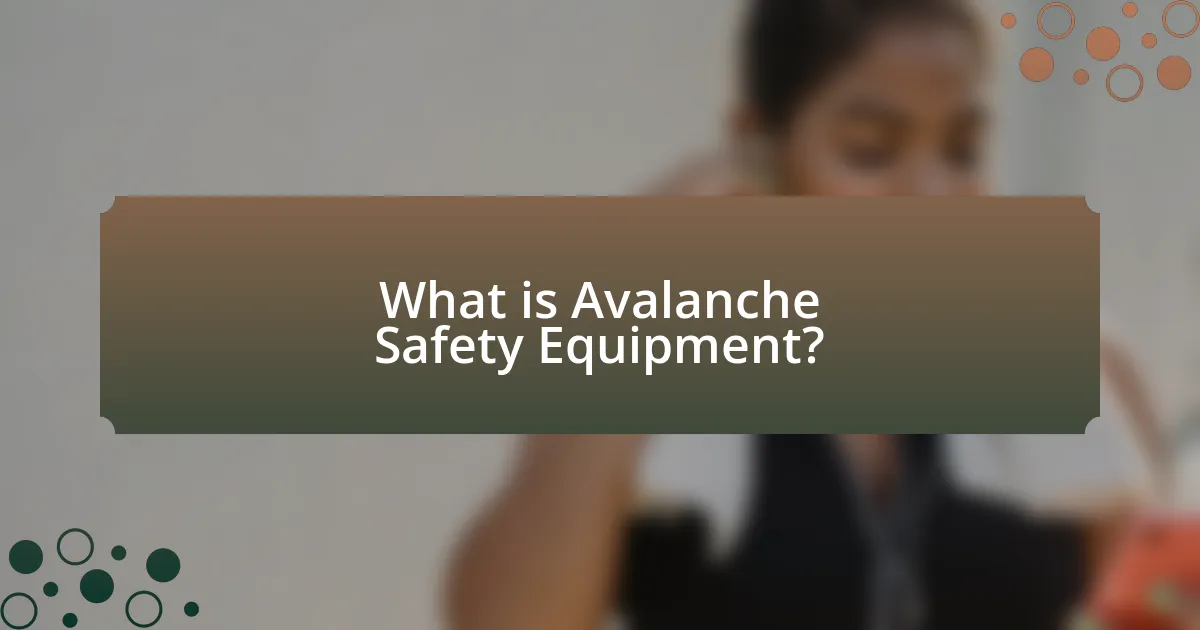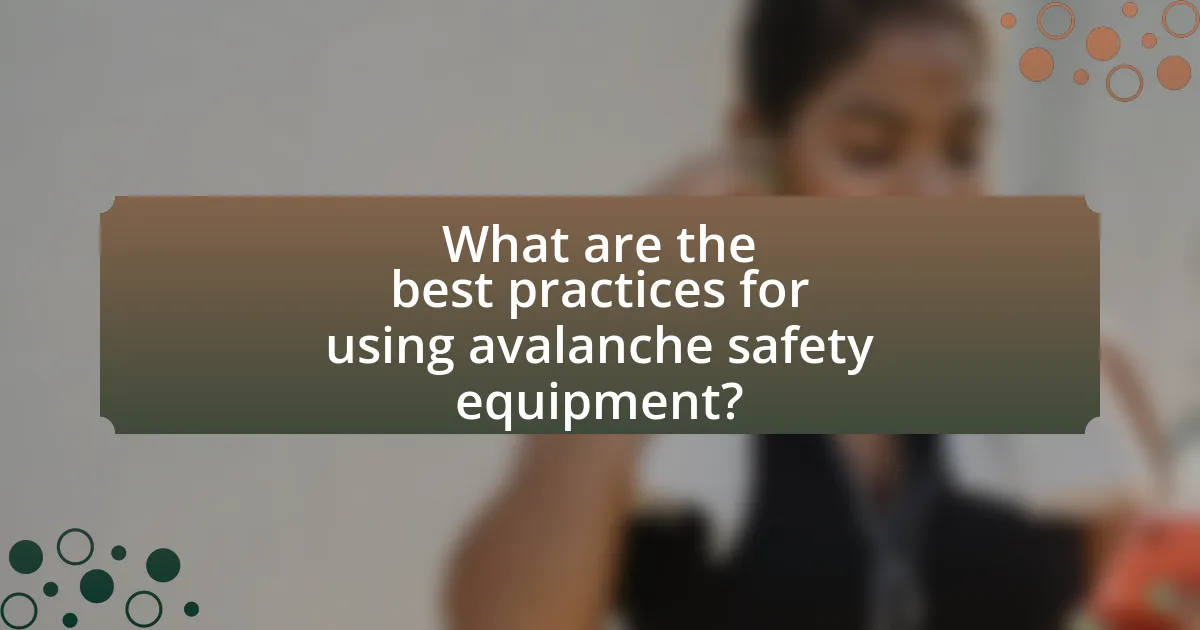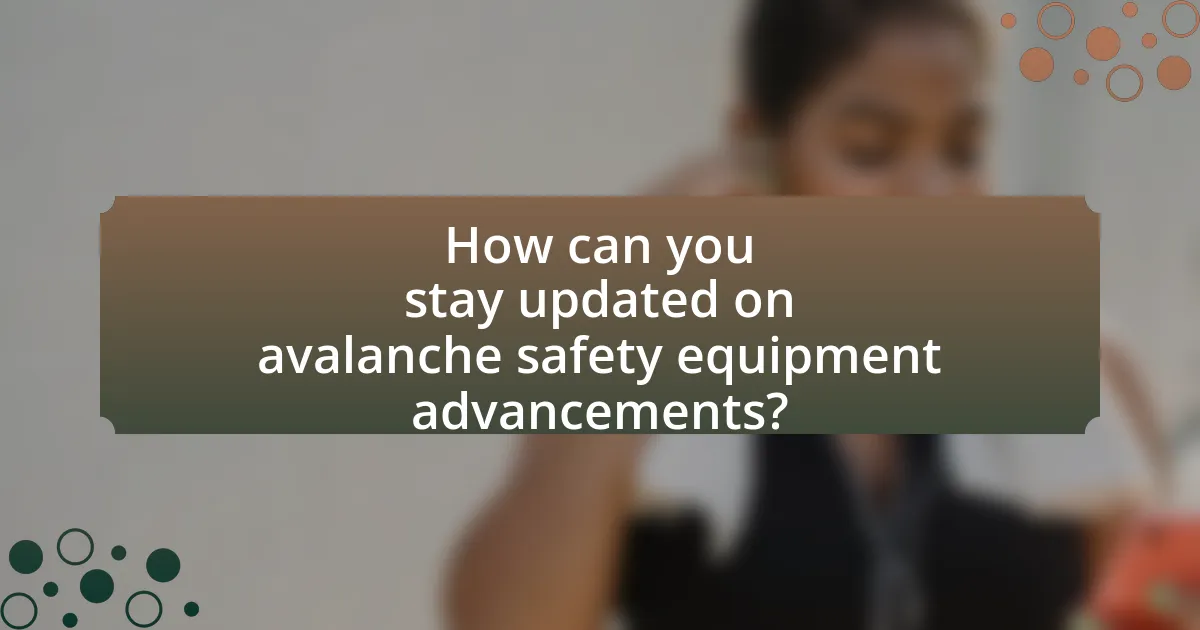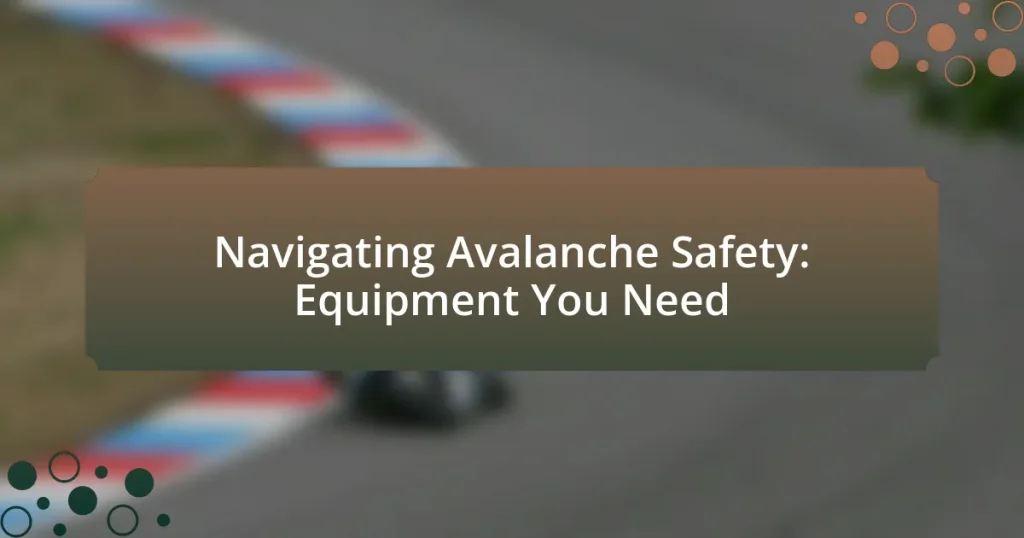Avalanche safety equipment is essential for individuals engaging in winter sports in avalanche-prone areas, significantly increasing survival chances during avalanche incidents. Key tools include avalanche transceivers for locating buried individuals, probes for pinpointing their exact location, and shovels for efficient excavation. The article discusses the risks associated with avalanches, the importance of proper equipment, and best practices for using this gear effectively. It also covers how to choose the right equipment, maintain it, and stay informed about advancements in avalanche safety technology.

What is Avalanche Safety Equipment?
Avalanche safety equipment refers to specialized tools and gear designed to enhance safety during backcountry skiing, snowboarding, and other winter activities in avalanche-prone areas. This equipment typically includes items such as avalanche transceivers for locating buried individuals, probes for pinpointing the exact location of a victim, and shovels for digging them out. According to the American Avalanche Association, using this equipment significantly increases the chances of survival in avalanche incidents, as timely rescue is critical.
Why is Avalanche Safety Equipment essential for outdoor activities?
Avalanche safety equipment is essential for outdoor activities in mountainous regions because it significantly increases the chances of survival during an avalanche incident. This equipment, which includes items such as avalanche transceivers, probes, and shovels, enables individuals to locate and rescue buried victims quickly. For instance, studies show that timely rescue efforts can improve survival rates, with victims found within 15 minutes having a 90% chance of survival, while those buried for over 35 minutes face a drastically reduced survival rate. Therefore, possessing and utilizing avalanche safety equipment is crucial for ensuring safety and preparedness in avalanche-prone areas.
What are the risks associated with avalanches?
Avalanches pose significant risks, including injury or death to individuals caught in the slide, property damage, and environmental impact. Statistics indicate that approximately 150 people die in avalanches each year in North America alone, highlighting the life-threatening nature of these events. Additionally, avalanches can destroy infrastructure, such as roads and buildings, leading to costly repairs and disruptions. The unpredictable nature of avalanches further complicates safety measures, as they can occur suddenly and without warning, making it essential for individuals in avalanche-prone areas to be aware of these risks and take appropriate precautions.
How can proper equipment mitigate these risks?
Proper equipment can mitigate avalanche risks by enhancing safety through improved detection, protection, and rescue capabilities. For instance, avalanche transceivers allow for quick location of buried individuals, significantly increasing survival rates; studies show that timely rescue within 15 minutes can lead to survival rates above 90%. Additionally, using snow safety gear like shovels and probes enables efficient excavation and victim recovery, further reducing the time spent in life-threatening conditions. Furthermore, avalanche airbags can prevent burial by keeping individuals on the surface during an avalanche, as research indicates that users of such devices have a higher chance of survival compared to those without.
What types of equipment are included in avalanche safety gear?
Avalanche safety gear includes essential equipment such as avalanche transceivers, probes, and shovels. Avalanche transceivers allow users to locate buried individuals by emitting and receiving signals, which is crucial during rescue operations. Probes are used to pinpoint the exact location of a buried person or object, while shovels are necessary for digging out snow and debris. These tools are vital for effective avalanche rescue and have been proven to significantly increase survival rates in avalanche incidents.
What is the purpose of an avalanche beacon?
The purpose of an avalanche beacon is to locate individuals buried under snow after an avalanche. These devices emit a radio signal that can be detected by other beacons, allowing rescuers to pinpoint the location of a buried person quickly. According to the American Avalanche Association, using a beacon significantly increases the chances of survival, as timely recovery is critical in avalanche situations.
How does a probe assist in avalanche rescue operations?
A probe assists in avalanche rescue operations by allowing rescuers to accurately locate buried victims beneath the snow. The long, slender design of the probe enables searchers to penetrate the snowpack and identify the precise location of a person trapped under the avalanche debris. Studies indicate that using a probe can significantly reduce the time taken to locate victims, which is critical since survival rates decrease rapidly after an avalanche occurs. For instance, a probe can help pinpoint a victim within a few centimeters, enhancing the efficiency of the rescue operation and increasing the chances of survival.
What role does a shovel play in avalanche safety?
A shovel plays a critical role in avalanche safety by enabling quick and efficient rescue operations for buried individuals. In the event of an avalanche, rescuers use shovels to dig through snow and debris to locate and extricate victims, significantly increasing the chances of survival. Studies indicate that survival rates decrease dramatically after 15 minutes of burial, making the speed of rescue essential. Therefore, having a shovel as part of avalanche safety equipment is vital for effective response and recovery efforts.
How do you choose the right avalanche safety equipment?
To choose the right avalanche safety equipment, prioritize essential items such as a beacon, shovel, and probe, as these are critical for effective avalanche rescue. The beacon allows for locating buried individuals, while a shovel is necessary for digging them out, and a probe helps pinpoint their exact location. Research indicates that having these three items significantly increases survival rates in avalanche situations, with studies showing that timely rescue can reduce fatalities by up to 90%. Additionally, ensure that the equipment is certified and meets safety standards, as this guarantees reliability in emergency situations.
What factors should be considered when selecting avalanche beacons?
When selecting avalanche beacons, key factors include transmission range, battery life, ease of use, and multiple burial detection capabilities. Transmission range is crucial as it determines how far the beacon can send and receive signals, with effective beacons typically offering a range of 40 meters or more. Battery life is important for reliability; modern beacons often use lithium batteries that can last up to 200 hours in transmit mode. Ease of use is essential for quick operation in emergencies, with intuitive interfaces and clear displays being preferable. Additionally, multiple burial detection is vital for locating more than one victim, with advanced beacons providing features that help differentiate signals from multiple sources. These factors collectively enhance the effectiveness and reliability of avalanche beacons in critical situations.
How do you determine the best probe length for your needs?
To determine the best probe length for your needs, assess the typical snow depth in your area and the specific conditions you may encounter. For example, a probe length of 240 cm is generally suitable for most backcountry situations, as it allows for effective searching in depths up to 200 cm, which is common in many avalanche-prone regions. Additionally, consider the type of terrain you will be navigating; steeper slopes may require longer probes to reach buried victims effectively. Research indicates that using a probe that is at least as long as the average snow depth enhances the chances of locating a buried person quickly, which is critical for survival in avalanche scenarios.
What features should you look for in an avalanche shovel?
When selecting an avalanche shovel, prioritize features such as a durable blade, a telescoping handle, and lightweight materials. A durable blade, often made from aluminum or high-strength plastic, ensures effective digging in hard snow conditions. A telescoping handle allows for compact storage and ease of use, while lightweight materials facilitate portability during backcountry travel. Additionally, consider a shovel with a wide blade for efficient snow removal and a comfortable grip for better handling. These features collectively enhance the shovel’s performance and usability in emergency situations.
How can you ensure your avalanche safety equipment is effective?
To ensure your avalanche safety equipment is effective, regularly inspect and maintain all gear, including beacons, probes, and shovels. Regular inspections should include checking batteries in beacons, ensuring probes are straight and functional, and verifying that shovels are intact and easily deployable. According to the American Avalanche Association, equipment that is well-maintained and properly used can significantly increase survival rates in avalanche incidents. Additionally, practicing with the equipment in realistic scenarios enhances familiarity and effectiveness during emergencies.
What maintenance practices are necessary for avalanche beacons?
Regular maintenance practices for avalanche beacons include checking the battery condition, performing regular functionality tests, and ensuring the device is clean and free from damage. Battery checks should be conducted before each use, as low battery levels can impair performance; many manufacturers recommend replacing batteries annually or after significant use. Functionality tests, such as sending and receiving signals, should be performed to confirm that the beacon operates correctly; this can be done using a test mode available on most devices. Additionally, keeping the beacon clean from dirt and moisture is essential, as contaminants can affect its performance. Following these practices ensures reliability in emergency situations, as evidenced by user manuals from leading manufacturers like Mammut and BCA, which emphasize the importance of regular maintenance for optimal safety.
How often should you inspect your avalanche probe and shovel?
You should inspect your avalanche probe and shovel before each use and at least once a season. Regular inspections ensure that the equipment is functioning properly and free from damage, which is critical for safety in avalanche conditions. According to the American Avalanche Association, equipment failure can significantly increase risks during backcountry travel, making it essential to verify the integrity of your gear regularly.

What are the best practices for using avalanche safety equipment?
The best practices for using avalanche safety equipment include regular training, proper maintenance, and correct usage of each device. Regular training ensures that users are familiar with the equipment’s operation, which is crucial in emergency situations. For example, practicing beacon searches can significantly reduce recovery time during an avalanche rescue. Proper maintenance involves checking batteries, ensuring that transceivers are updated, and inspecting shovels and probes for functionality before each outing. Correct usage means wearing avalanche transceivers at all times in avalanche-prone areas, using shovels and probes effectively during rescues, and understanding the limitations of each piece of equipment. These practices are supported by avalanche safety organizations, which emphasize the importance of preparedness and knowledge in reducing avalanche-related fatalities.
How should you properly use an avalanche beacon?
To properly use an avalanche beacon, first ensure that the device is fully charged and set to transmit mode before entering avalanche-prone areas. This allows the beacon to send out a signal that can be detected by other beacons during a search. When searching for a buried person, switch the beacon to search mode, which enables it to pick up signals from nearby beacons.
Next, perform a systematic search pattern, starting with a wide arc and gradually narrowing down to pinpoint the location of the buried individual. Once you receive a signal, follow the directional arrows and distance indicator on the beacon to locate the victim accurately.
It is essential to practice using the beacon regularly, as familiarity with its functions and features can significantly improve search efficiency in real-life situations. According to the American Avalanche Association, regular practice with avalanche beacons can enhance rescue times and increase the chances of survival for buried individuals.
What steps should you follow to search for a buried person?
To search for a buried person, first, ensure you have the necessary equipment, including a transceiver, probe, and shovel. Begin by conducting a systematic search using the transceiver to locate the person’s signal, which can guide you to their approximate location. Once you have a signal, mark the spot and use the probe to pinpoint the exact burial depth. After confirming the location, use the shovel to carefully excavate the snow, ensuring to maintain the integrity of the area around the buried person. This method is supported by avalanche safety protocols, which emphasize the importance of using specialized equipment and techniques for effective rescue operations.
How can you effectively communicate with your team during a rescue?
To effectively communicate with your team during a rescue, establish clear roles and use concise, direct language. This approach minimizes confusion and ensures that each team member understands their responsibilities and the situation at hand. Research indicates that effective communication in high-stress environments, such as rescue operations, can significantly improve outcomes and coordination among team members. For instance, a study published in the Journal of Emergency Management highlights that structured communication protocols enhance situational awareness and decision-making efficiency during emergencies.
What techniques should you employ when using a probe?
When using a probe for avalanche safety, employ techniques such as systematic probing, proper placement, and effective communication. Systematic probing involves creating a grid pattern to ensure thorough coverage of the search area, which increases the likelihood of locating a buried victim. Proper placement of the probe is crucial; it should be inserted vertically and pushed down with a firm, steady motion to penetrate the snow effectively. Effective communication among team members is essential to coordinate efforts and share findings quickly, enhancing the overall efficiency of the search. These techniques are supported by avalanche safety guidelines, which emphasize the importance of organized and methodical approaches in rescue scenarios.
How do you effectively locate a victim with a probe?
To effectively locate a victim with a probe, insert the probe vertically into the snow at regular intervals in a systematic grid pattern around the last known location of the victim. This method ensures thorough coverage of the area and increases the likelihood of making contact with the victim. Research indicates that using a probe in this manner can significantly enhance the chances of locating buried individuals quickly, as it allows rescuers to identify the victim’s position based on the resistance felt when the probe strikes the victim’s body.
What are the common mistakes to avoid while probing?
Common mistakes to avoid while probing include not maintaining proper spacing between probes, failing to probe in a systematic pattern, and not using the correct probe length for the snow conditions. Maintaining proper spacing ensures thorough coverage of the area, while a systematic pattern increases the likelihood of detecting buried victims. Using an appropriate probe length is crucial, as shorter probes may miss deeper victims, and longer probes can be cumbersome in certain conditions. These mistakes can significantly hinder search efforts and reduce the chances of a successful rescue.
What are the key considerations when using a shovel in avalanche situations?
The key considerations when using a shovel in avalanche situations include the shovel’s size, shape, and material, as well as the technique employed during excavation. A shovel with a wide blade and a sturdy handle is essential for efficiently moving snow, while a lightweight material like aluminum enhances portability without sacrificing strength. Proper technique, such as using a scoop-and-lift motion, maximizes efficiency and minimizes fatigue during rescue operations. These considerations are critical because effective shoveling can significantly impact the speed of locating and rescuing buried individuals, which is crucial in life-threatening avalanche scenarios.
How can you maximize efficiency when digging in snow?
To maximize efficiency when digging in snow, use a combination of proper tools, techniques, and body mechanics. Employ a snow shovel designed for the task, as it allows for easier lifting and moving of snow. Utilize a technique that involves bending at the knees and keeping your back straight to reduce strain and increase power. Additionally, work in a systematic pattern, such as digging in rows or sections, to ensure thoroughness and prevent unnecessary backtracking. Research indicates that using ergonomic tools can reduce fatigue and increase productivity, making the digging process more efficient.
What techniques can improve your chances of a successful rescue?
To improve your chances of a successful rescue in avalanche situations, employing techniques such as effective communication, proper use of rescue equipment, and maintaining situational awareness is essential. Effective communication among team members ensures that everyone is aware of the rescue plan and can coordinate their efforts efficiently. Utilizing rescue equipment like avalanche beacons, probes, and shovels increases the likelihood of locating and extracting a buried individual quickly. Maintaining situational awareness allows rescuers to adapt to changing conditions and make informed decisions during the rescue process. These techniques are supported by studies indicating that timely communication and the use of specialized equipment significantly enhance rescue outcomes in avalanche scenarios.

How can you stay updated on avalanche safety equipment advancements?
To stay updated on avalanche safety equipment advancements, regularly follow industry publications, attend relevant conferences, and participate in online forums dedicated to avalanche safety. Industry publications such as the Avalanche Review provide insights into the latest research and equipment innovations. Conferences like the International Snow Science Workshop showcase cutting-edge developments and expert discussions. Additionally, online forums and social media groups focused on avalanche safety allow for real-time updates and community sharing of new equipment and techniques. These resources collectively ensure access to the most current information in avalanche safety equipment.
What resources are available for learning about new avalanche safety gear?
Online platforms such as the American Avalanche Association (AAA) and Avalanche.org provide comprehensive resources for learning about new avalanche safety gear. These platforms offer updated information, gear reviews, and educational materials specifically focused on avalanche safety equipment. Additionally, manufacturers like Black Diamond and Mammut often have detailed product descriptions and safety guidelines on their websites, which can help users understand the latest advancements in avalanche gear. Furthermore, instructional videos and courses available on platforms like YouTube and specialized avalanche safety training organizations enhance practical knowledge about using this equipment effectively.
How can you participate in avalanche safety training programs?
To participate in avalanche safety training programs, individuals can enroll in courses offered by organizations such as the American Avalanche Association or local ski patrols. These programs typically include both classroom instruction and practical field training, focusing on avalanche awareness, rescue techniques, and safety equipment usage. According to the American Avalanche Association, participating in these structured training sessions significantly enhances knowledge and skills necessary for safe backcountry travel, thereby reducing the risk of avalanche incidents.
What role do online communities play in sharing equipment knowledge?
Online communities play a crucial role in sharing equipment knowledge by facilitating the exchange of information, experiences, and best practices among users. These platforms enable individuals to discuss specific gear, share reviews, and provide insights on equipment performance in real-world scenarios, which is particularly valuable in niche areas like avalanche safety. For instance, forums and social media groups dedicated to outdoor activities often feature discussions where experienced users offer advice on the latest safety equipment, enhancing collective knowledge and promoting informed decision-making. This collaborative environment not only helps users make better purchasing choices but also fosters a culture of safety and preparedness within the community.
What are the latest trends in avalanche safety equipment technology?
The latest trends in avalanche safety equipment technology include the integration of advanced digital technologies, such as GPS and smartphone connectivity, into avalanche transceivers and beacons. These modern devices enhance search efficiency by providing real-time location tracking and improved signal processing, allowing rescuers to locate buried individuals more quickly. For instance, recent models like the Mammut Barryvox S and the Pieps Micro BT feature Bluetooth connectivity, enabling users to update firmware and manage settings via mobile apps. Additionally, the development of lightweight materials and ergonomic designs in avalanche airbags has improved user comfort and deployment speed, making them more effective in emergency situations. These advancements reflect a growing emphasis on user-friendly, efficient, and reliable safety equipment in the avalanche safety sector.
How are advancements in beacon technology improving safety?
Advancements in beacon technology are improving safety by enhancing the accuracy and speed of locating individuals in avalanche situations. Modern beacons utilize digital signal processing and multiple frequency bands, allowing for more precise tracking of buried victims. For instance, the latest avalanche beacons can transmit and receive signals simultaneously, significantly reducing search times. Research indicates that these advancements can decrease the average rescue time from over 30 minutes to under 10 minutes, which is critical for survival in avalanche scenarios.
What innovations are being made in avalanche shovels and probes?
Innovations in avalanche shovels and probes include the development of lightweight materials, ergonomic designs, and integrated technology for enhanced functionality. Manufacturers are utilizing advanced composites and aluminum alloys to reduce weight while maintaining strength, making shovels easier to carry and use in emergency situations. Ergonomic handles and blade shapes are being designed to improve user comfort and efficiency during digging. Additionally, some probes now feature built-in digital displays that provide real-time depth readings and GPS tracking, allowing for more accurate and efficient search efforts. These advancements are aimed at increasing the effectiveness and safety of avalanche rescue operations.
What practical tips can enhance your avalanche safety preparedness?
To enhance your avalanche safety preparedness, regularly practice using avalanche safety equipment, including transceivers, probes, and shovels. Familiarity with this gear increases efficiency in emergency situations, as studies show that timely rescue can significantly improve survival rates. Additionally, take an avalanche safety course to understand terrain assessment and snowpack evaluation, which are critical for identifying potential avalanche risks. Research indicates that individuals trained in avalanche safety are better equipped to make informed decisions in the backcountry, reducing the likelihood of accidents. Always check avalanche forecasts and conditions before heading out, as this information can guide your route choices and increase safety.
How can you create a checklist for your avalanche safety gear?
To create a checklist for your avalanche safety gear, start by identifying essential items that ensure safety in avalanche-prone areas. Key items include a beacon, shovel, probe, first aid kit, and extra layers of clothing. Each item serves a specific purpose: the beacon helps locate buried individuals, the shovel is crucial for digging, the probe assists in pinpointing the location of a victim, and the first aid kit addresses injuries.
To ensure completeness, categorize the gear into sections such as rescue equipment, personal safety, and emergency supplies. Regularly review and update the checklist based on the latest safety guidelines and personal experiences. This methodical approach enhances preparedness and increases safety during backcountry activities.
What should you do before heading out into avalanche-prone areas?
Before heading out into avalanche-prone areas, you should conduct thorough research on current avalanche conditions and forecasts. This involves checking local avalanche reports, which provide critical information on snow stability and risk levels. For example, the Colorado Avalanche Information Center publishes daily updates that detail avalanche danger ratings and specific terrain advisories. Additionally, familiarize yourself with the terrain and identify potential avalanche paths. Understanding these factors significantly enhances safety and preparedness in high-risk environments.
